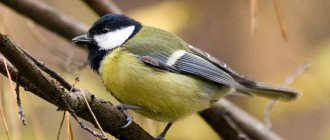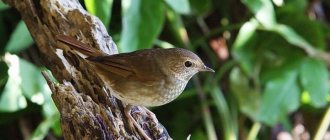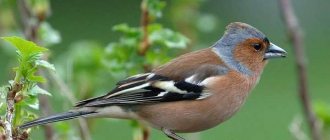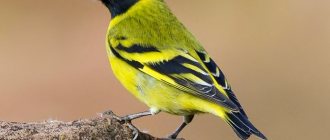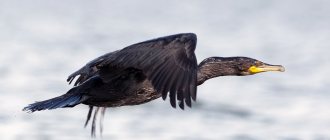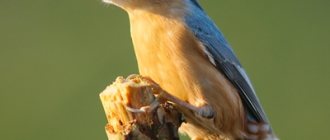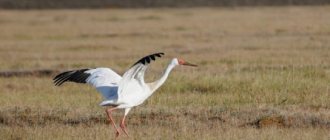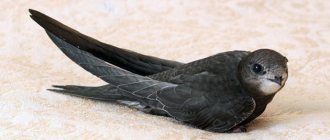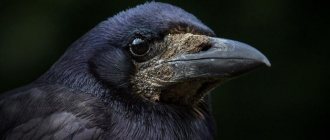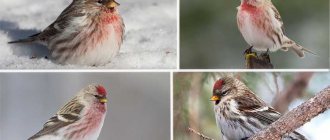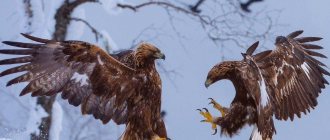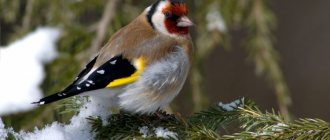People who are just planning to have a bird in their home are advised to choose a siskin. He is unpretentious in keeping, has a calm disposition and easily gets used to people and other animals. This bird is often compared to a parrot, because it is not inferior to the overseas beauty in mental abilities and memory. Despite the fact that they live in natural conditions, siskins are excellent for keeping at home. Even captured adults can be tamed. The bird quickly gets used to its new owner and is easy to accustom to handling.
Keeping siskins at home
The back of the head and neck are black. It has a small spot under the beak and yellow stripes above the eyes.
The siskin is a songbird that sings its trills and imitates other species. When kept in a house, a bird can delight a person with its “tiili-tili” for up to 10 months per year. Among all singing species, siskins are the fastest to get used to hands and a new home. Even a caught adult will quickly get comfortable in the cage.
In the wild, siskins live for 3 years, but in captivity they can live longer. How many years do they live in a cage? It all depends on the conditions of detention and feeding. With good care, pets can live up to 10-15 years.
Maintenance and care
The gullibility, friendliness and intelligence that characterize the siskin have made it one of the favorite songbirds for home keeping.
Due to its simple nature, the siskin often falls into various traps or becomes a victim of predators.
- In captivity, it quickly tames and becomes attached to its owners. He calmly flies around the room outside the cage and often flirts with people. A little feathered friend can sit on the head or shoulder of its owner, rub its beak on the earlobe, drink water from its mouth and perform any other tricks that a smart bird can be trained to do.
- Keeping siskins in captivity is not at all difficult. Even a small cage will suit him, and the peace-loving bird easily gets along with birds of other breeds. Therefore, siskins can be kept in a common cage or aviary with many species of birds.
- Siskin songs can lift your spirits with their cheerfulness and cheerful, non-annoying notes, and they are ready to sing 10 months a year! Despite the fact that they live outside their own free will, these cute creatures feel comfortable and even playful in their cage, as if they were born there. Having become accustomed to humans, the siskin becomes unusually tame and affectionate, greeting its owners with gentle chirping and sincere joy.
- The caught siskin will not be shy for long about its new home, it will immediately begin to shell hemp or millet grains, and already on the third day it will begin to hum its tunes and calmly tolerate the presence of a person nearby. If possible, the cage should be spacious; the restless bird loves to play mischief. When he gets used to the house, you can let him out of the cage without fear, having first closed the windows and doors. He will always return to his place. Of all songbirds, siskins are considered the most tame, so if necessary, catching one will be quite easy.
- Siskins are fed regular grain mixtures, with the main content of millet and oatmeal. You can imitate natural food by mixing seeds of coniferous trees, alder, birch, dandelion and plantain. Some fresh fruits and vegetables are good for them, for example: apples, carrots, greens.
The bird quickly gets used to humans and becomes completely tame
Contents in the house
Siskin is an unpretentious bird that is easy to care for. The siskin is kept in a separate cage or together with other birds. They can be not only representatives of this species, but also other small birds (finches, canaries). When moving in, you should take into account the characters of your future neighbors.
If you decide to place your pet in a separate house, you should take its parameters into account. The minimum size of the cage should be 40 cm in length, 40 cm in width and 30 cm in height. Don't forget to place a box of water in the cage where the bird can bathe, because it needs to keep its feathers clean. Separately, you need to place a container for water that your pet will drink. Don't forget to change the water in the cage regularly.
There should be a special box in the cage for sand. With the help of purified river grains of sand in their crops, birds help their bodies process food. In addition to sand, you can add eggshells, chalk and charcoal to the box, which are also good for your pet's health.
It is advisable to place a cane in the cage, which will replace the pet's branches. This species is accustomed to them in its natural environment. It is best to attach several perches at once for easy movement of the bird. Please note that the reeds should not be even, because they lead to underdeveloped paws and their diseases. Uneven sticks are a good trainer for them. In addition, every day you need to let the siskin fly around the apartment. There is no need to close the cage, because the bird itself will return to its house when it flies.
I want a siskin: keeping a bird!
Siskins can be worthy competition not only in terms of beauty. They are more intelligent than overseas pets. Thanks to their well-developed natural memory, having become accustomed to the owner caring for him, they are able to recognize him among the rest of the household. As soon as this person appears in the bird's field of vision, the bird immediately becomes playful and begins to sing.
This may seem surprising, but the Chizhu have a high level of culture and discipline, just like the Amazons. The presence of such qualities does not give cause for concern if they accidentally forgot to close the cage door: the prisoner will not escape anywhere and, moreover, will not leave traces of vital activity in the room anywhere. The siskin will immediately return back to its small home at the command of its owner. The bird easily gets used to this. It is precisely because nature has endowed the siskin with unsurpassed memory and a sharp mind that it can be taught the correct behavior without much effort.
Siskin easily finds a “common language” with other inhabitants of the bird hostel and never gives rise to a quarrel. If any of the novice breeders decides to acquire this beautiful bird, then he should be prepared for the fact that the character of each of the individuals, like a person, has individual characteristics. Of course, everything described above in the previous paragraphs is true for most siskins, but the birds differ slightly from each other in habits, preferences, etc.
Keeping a siskin will not seem difficult for those who intend to acquire this bird. By following a very small amount of recommendations, you can be sure that the siskin will always be in high spirits, as evidenced by cheerful trills.
The neatness of the siskins is pleasantly pleasing. The cage must contain a container filled with water to meet hygienic needs, i.e. water procedures. Clean birds will be able to maintain their unusually bright plumage in excellent condition. Separately, you need to place a container with clean water so that the bird can quench its thirst
It is important to keep the water clean and change the water periodically so as not to create additional preconditions for deterioration of health.
The minimum width and length of the lattice dwelling should be 40 by 40, and the height should be 10 centimeters less. Peacefulness and kindness can harm a siskin if he has to coexist with representatives of birds whose character is far from angelic. This circumstance must be taken into account when organizing a bird “hostel” - the morals of the inhabitants, as well as the sizes, should not differ.
One of the conditions for good absorption of food by a siskin, like any other bird, is the presence of small grains of sand in its crop. Therefore, a feeder should be attached to the wall of the cage, into which purified river sand should be poured. You can also add mineral supplements that are beneficial to the body in the form of eggshells, chalk and charcoal.
You can create conditions as close as possible to the natural habitat by attaching different perches. There should be as many of these accessories as possible. Thus, the interval will be very small; therefore, the siskin will be able to easily jump over rather than fly between the perches. Any owner or housewife can make such simple structures with their own hands, using twigs as material. The perches should not be even so that the siskin does not develop diseases of the limbs (legs) while staying in the cage.
Siskins are on the move most of the time, and being constantly in a cage constrains them. Therefore, it is necessary to open the cage and release the prisoner so that he can enjoy free flights indoors. Leave the door open - the siskin will fly back freely when it sees fit. Otherwise, the bird will get worried, and this will have a positive impact on its health.
Feed selection
Siskin is unpretentious in choosing food. You just need to provide him with a varied diet, which is the key to a long life and the possibility of offspring in the bird. Your pet's diet includes the following products:
- Specialized food for canaries. The seeds can be mixed with millet, rapeseed and lettuce seeds. The daily amount of poultry feed is 2 teaspoons.
- The seeds of such plants are birch, alder, pine, spruce, quinoa, dandelion, poppy, flax, rapeseed. The bird is accustomed to it in nature.
- Pressed sunflower and hemp seeds. This food should not be overused, because too much fatty food will lead to obesity in the bird.
- Greens (woodlice, dandelions, lettuce in summer, and white cabbage leaves, cereal sprouts, willow and birch twigs in winter.
- Vegetables and fruits - carrots, apples, pumpkin. Before serving, they need to be cut into small pieces, or better yet, grated.
- Boiled eggs and rice should be given during feather changes to keep the new feathers healthy and beautiful.
- Larvae of beetles and other insects are also included in the list of siskin’s favorite foods. If the owner can get this treat, the pet will be very happy.
- Crushed pine nuts are a special treat for siskins.
Feeding the Siskin
You need to take care of what your pet will eat long before purchasing it. After all, for him, like for any other living creature, the regular intake of vitamins, minerals and trace elements into the body is very important. You need to know which foods are good for the siskin, and which ones are best not given. The key to bird health is a varied diet. If the bird feeds on a mixture of different seeds, then the siskin will not only give you its songs all year round, but will also delight you with its offspring.
For most poultry, hemp is harmful, but the siskin’s body hardly reacts to it. Poppy, rapeseed, flax, rapeseed, birch and alder seeds - the siskin eats all this with pleasure. In addition to seeds, the diet should include greens. In summer, give him dandelion leaves or lettuce, in winter - birch or willow twigs, sprouted cereals, and white cabbage. Let's peel some pieces of apple, carrot or pumpkin. It is better not to give pears, as problems with the functioning of the gastrointestinal tract may begin. Boil and chop an egg, boil rice - such soft food should also be present in the diet, especially during the molting period. The siskin is a granivorous bird, but ant eggs and insect larvae are present in the daily diet of free-living birds.
Spruce and pine seeds are a delicacy for siskins, but in winter you can’t get the seeds of blossoming cones, give them regular spruce needles, the siskin will get pleasure and vitamins.
If you don’t have the time and opportunity to make mixtures yourself, or you don’t want to rack your brains over compiling his daily menu, buy mixed food in the store. But you can’t save on the bird’s health; buy food only from trusted manufacturers.
Reproduction of siskins
Siskins breed in captivity in late February and early March. Showing is a special behavior of birds during the mating season in order to attract the opposite sex. During the mating season, the siskin changes in behavior: it constantly sings, lifts its head high, and holds its tail like a fan. After that, he chases the female around the cage.
If you want to breed siskins at home, you should prepare the cage for nesting. In a quiet corner of the cage at a height of 15 cm, you need to secure the branches with a rope basket, which is sold at a veterinary pharmacy. Such baskets are sold for breeding canaries, but they are also suitable for siskins. At the bottom of the cage you need to throw small things - branches, moss, feathers, cotton wool. The couple will make a nest from the basket and these materials.
After constructing the nest, the female lays 4-5 eggs there. They are small (only 1.5 cm long), white or green-blue with red specks or stripes. The female stays in the nest all the time, and the male feeds her, bringing food from the feeder. During breeding, birds should be left alone and the cage should be cleaned less often. The nesting period is from late April to early May. After 2 weeks, the chicks appear.
The babies stay in the nest for 2 weeks. In the natural environment, parents feed the chicks with larvae and beetles. In cage conditions, you can feed the brood with a hard-boiled chicken egg. It is ground, ground breadcrumbs from the loaf and grated carrots are added. Food should have a crumbly consistency. In addition, they are given by soaked and dried millet and rapeseed seeds, dandelion and wood lice. After a month, the young siskins are removed from their parents, and they can again give birth to offspring, because siskins breed twice a year.
Description of the siskin
Siskin is a representative of the passerine order. This bird is small in size. On average it reaches 12 cm in length, weighing from 10 to 18 g.
Appearance
The siskin has a small head with coal-black eyes and a rounded body, two to three times the size of the head itself, a small triangular gray beak and thin brown legs with hooked fingers and short claws to make it convenient to cling to branches.
The plumage color of the siskin is greenish-yellow, mixed with black, dark gray and olive. The female siskin's abdomen is covered with dark stripes or spots.
The male has a more variegated and brighter color than the female, the feathers in the tail and wings, on which stripes of white, black and yellow are visible, are longer, and on the head there is a spot of dark gray or black feathers, the so-called “cap”, and a small black spot or “penny” may appear on the chin.
Lifestyle and behavior
Siskins can appear very restless and even chaotic in their behavior due to their activity. But it is not so. Birds of this species are incredibly united, have a hierarchical system in flocks, and even belong to a species that involves “sharing” food, that is, regurgitating their food to another member of the flock from the dominant group.
Siskins always live in pairs, especially in summer during nesting. The male and female equally take part in the construction of the family nest, preferring to build it on the top of a tree, most often a coniferous one.
They generally try to stay higher off the ground. Closer to autumn, siskins form small flocks, and in winter their migration begins. Usually, if a siskin settles in a warm place, there is no need to change the place.
Therefore, flocks either remain where they settled, or fly short distances, closer to deciduous or mixed forests. And if an ice-free body of water is encountered along the way, the flock will remain there for the winter.
Sometimes it happens that part of one large flock flies over, while the other remains in the same place. Flocks always try to stay together, staying nearby. Up to six pairs with nests can be located on two trees standing nearby.
The sonorous singing of siskins, creating a friendly and romantic atmosphere, can always be clearly recognized. In addition to its natural “style” of singing, the siskin also has the ability to well parody its neighbors - birds of other species, especially tits. It is precisely for their beautiful singing and friendly peaceful nature that siskins are so popular as pets.
How long do siskins live?
From 1955 to 1995, ornithologists banded about 15 thousand individuals in the Leningrad region. Upon repeated captures, it turned out that only two of all those ringed lived to 3.5 years, one to 6 years, and one more lived to 8 years. In 1985, a 25-year-old siskin was recorded, but this, of course, is an exceptional case.
In nature, due to the possible probability of attack or destruction of the nest, as well as constant migration, the average life expectancy of siskins is only 1.5 years, that is, the population is completely renewed within 2 years. When in captivity, a siskin will live much longer, up to 9-10 years.
Diseases and overcoming them
These birds rarely get sick. In the natural environment, siskins are more at risk of getting sick when interacting with other animals. This rarely happens when kept in a cage. The main thing is to make sure when purchasing that the siskin’s health is in order. Hold the animal you like in your hands, look at its reaction to you. Assess her weight, activity, appearance. Inspect for damage to the head, look into the bird's cloaca area - there should be no dirty, stuck together feathers.
Maintenance and care are the main factors of poultry health. Protect it from drafts, cold and heat. Clean the cage regularly and provide fresh water and food. It is better to keep several birds, and then they will live longer.
What kind of excitement reigns high in the birch crown? Nimble birds in discreet, perhaps even camouflage, plumage - they fly from branch to branch, talking in creaky trills! These are not goldfinches with their contrasting outfit, and not the famous nightingale singers... The gaze lingers for a second on the lemon feathers of the males and is ready to slide further... But don’t rush! Take a closer look at these birds, because they undoubtedly deserve the gaze of an observer.
Key Features
From the outside, it may seem that the birds fly chaotically from tree to tree, but this is not so.
After a little observation of the flock located on one of the trees, you can see how the siskins are talking among themselves.
Quietly chirping, they deftly jump from branch to branch in search of seeds, helping themselves with tenacious claws and beak.
After a signal given by the leader, the flock, with wave-like movements, flies together to another tree.
At the beginning of autumn, siskins gather in flocks, and with the onset of cold weather they go to wander to warmer areas. In winter, yellow-green birds can be seen just walking around the city.
Why is Chizha called that?
Once you hear the cheerful, hasty song of the siskin, it immediately becomes clear where this bird got its name. In noisy flocks, siskins call to each other with trills, in which creaks, crackles, squeaks and the constant buzzing “siskin” sounds can be clearly heard.
Often in this song you can find fragments borrowed from other birds. The naturalist writer Anatoly Onegov described the siskin song perfectly: “The siskin will sing and chirp, you will listen to the little singer, and it seems that it is not a bird, but a stream gently but hastily splashing among the warm pebbles, but then a pleasant stream comes to an end, and instead of that while a beautiful song was sounding, a completely unmelodic “chizhzhzhizhi” would suddenly be heard.
What do siskins look like?
Males and females among adult siskins are quite easy to distinguish by the color of their plumage.
The male siskin is small, but still elegant! Nature has generously endowed the siskin with all sorts of shades of yellow and green - here there are ocher, lemon, olive, and grayish-green, as if sprinkled with ashes... And how perfectly the contrast of a black cap and a bright yellow eyebrow on the head, and black and yellow complement the outfit feathers of wings and tail - it’s not for nothing that male siskins are called “little siskins”!
Female siskins are much more modestly colored: their heads are not crowned with a black cap, and their plumage does not have bright shades of yellow.
Dark longitudinal streaks on the sides and abdomen, grayish, modest shades of the same yellow-green range - all this is designed to make the female more invisible on the nest. Young siskins are similar in color to females, but by the spring of next year their plumage will acquire features characteristic of one sex or another.
Description of the bird
It is not surprising that the siskin - a small funny songbird - is very often called a siskin. Yes, and the song “Chizhik-Pizhik” is also about him. It is enough to see and hear this bird once to understand what causes such an affectionate attitude towards it.
Siskins belong to the finch family, which includes many wonderful singers. The size of this bird is small: only about 12-15 g body weight, body length - 12 cm, wingspan - 20-22 cm.
— Advertising —
And, despite the fact that siskins are very well camouflaged in the treetops, when you see this bird, it is very easy to recognize it. The plumage of an adult male siskin has a bright green-yellow coloring of the head, neck and abdomen. The dark wings are also decorated with lemon spots. And males, unlike females, “wear” a black cap on their heads. Females and young males are colored brownish-brown, sometimes with yellow splashes.
Where do siskins live?
Siskins are forest dwellers, mainly found in the forest zones of Europe and Asia. These birds prefer to colonize coniferous and mountain forests, but they can be found in forest-steppe and island steppe forests.
In summer, siskins live in pairs and remain inconspicuous and quiet. In autumn, young and adult birds gather in flocks, often of quite considerable size. They roam through deciduous forests, along rivers and streams; during this period, siskins can be found almost everywhere.
But the cold is getting closer, and the time is coming to fly away for the winter - to Southern Europe, the North Caucasus and Transcaucasia, to the south of Kazakhstan. However, there are exceptions: siskins can remain over the winter in areas rich in food, for example, in places where spruce, birch and alder forests come together, or near an ice-free forest reservoir.
Range and habitats
The siskin is a common bird throughout most of its range. And the area itself is quite large. It stretches across the entire forest zone of Eurasia from Ireland and Scandinavia to Sakhalin and Primorye. In the center of Siberia, the habitat is almost interrupted, despite the fact that there are places suitable for this bird to live here. This intermittency of the range can be explained by too long a winter, as well as by the fact that under these conditions deciduous trees and shrubs play a small role in the composition of plant communities. The typical taiga composition of plant species makes the food supply of the siskin too scarce.
In the south, the habitat of the siskin is replete with fragments of terrain free from the participation of this species in the composition of biocenoses. It nests in isolation in the Caucasus and Transcaucasia. This is due to the species being confined to mountain mixed forests. In the Far East, favorable conditions for siskins exist in Primorye, the Amur region, and Sakhalin, that is, where mixed coniferous-deciduous forests still survive.
Siskin is a migratory bird. However, he does not like to fly far. These movements can rather be called migrations. This bird waits out the winter in the southern Mediterranean, the Middle East, southern Iran, Japan, China, and Kazakhstan. Birds of this species prefer to live and nest permanently in coniferous forests, which often contain areas with deciduous trees.
This is interesting: Common capercaillie - description of the bird, habitat, reproduction
Reproduction of siskins
Siskins are non-conflicting, pairs often build nests close to each other, and males can even mat together in flight. The entire burden of construction work falls on the female in pairs. The nest of siskins is a cozy bowl, lined with soft mosses, roots and herbs, with feathers and fluff from plants. Siskins build it high in the crown of spruce and pine trees, carefully camouflaging it in the dense interweaving of side branches. In this atmosphere of coniferous coolness and mystery, the female lays 4-6 light bluish or greenish eggs with dark streaks. The eggs are also incubated by the female alone; the male takes on the labor of feeding his wife. Most often, siskins hatch chicks twice during the warm season.
Siskin diet
Siskins love small insects such as aphids, caterpillars and butterflies, as well as grass and tree seeds. The diet mainly depends on the time of year. Dandelion and poppy seeds are a treat for them in the summer. They can also obtain seeds of various asteraceous plants, such as thistle, cornflower and other herbaceous plants, such as St. John's wort, meadowsweet and sorrel.
For those who want to keep the bird indoors, you can also add fruits and vegetables to the siskin's diet, such as apples, carrots, and cabbage. You can also include oats and other seeds in your diet, which are often found in canary food.
From deciduous trees they love the seeds of birch, alder, and poplar. Thin fingers with hook-shaped claws and a pointed beak help them in their prey. Among the conifers, they love spruce, fir, pine, and also, if you are lucky, when the cones of coniferous trees bloom in the spring, siskins willingly feast on nuts.
Siskin in the house: maintenance and feeding
tit) and from small songs. tits: chi-pi, chi-pi... as well as the calls of other birds mixed with their own words. The more complex songs of other birds are distinguished by the siskin from its general, mating song, for example, the song of the bunting, and also the warblers are performed more often “screaming”. These two songs, and also the song of the so-called “grasshopper,” are, however, rarely found in the siskin, but nevertheless they are found, and then the siskin, this simple bird, as they say, without songs, becomes an excellent singer.”
— Most people strongly associate the image of a siskin with the famous children's song about “Chizhik-fawn.” Historically, these comic couplets are associated with the School of Law, located in the 19th - early 20th centuries. in St. Petersburg on the embankment of the Fontanka River. The students of this school wore green uniforms with yellow buttonholes, reminiscent of siskin plumage.
“Thanks to this song, in 1994 a monument to the siskin was erected on the Fontanka River. The cute little bird on the pedestal immediately acquired signs: if you make a wish and throw a coin so that it remains lying on the pedestal of the monument, the wish will certainly come true.
— A German legend says that siskins hide magic pebbles in their nests that make their home invisible. But you and I now know that siskins are simply skilled camouflage builders and know how to choose inaccessible places for nest-building!
— A portrait of a siskin adorned stamps issued in Poland, Gibraltar, Benin and Belgium.
Is the siskin a migratory bird or a sedentary one?
Siskins are typical migratory birds. At the end of September they gather in large flocks and move south – closer to the warmth. That is why in winter you can often find siskins, for example, in the Crimea. Only in very rare cases, if in their habitat these birds find an ice-free body of water - a river, lake, stream - they can stay near it for the winter.
Video - siskins at the feeder
You and I have learned a lot about the siskin, now let's look at these birds live!
Author of the article: Irina Demina
The poultry farmer needs to firmly grasp the immutable truth: just as we need a bright, clean and comfortable room, the bird needs a clean, bright and cozy cage. Therefore, when constructing a cage, you need to know what kind of bird it is intended for. So, for example, for siskins, goldfinches, tap dancers and tits, which love to climb and jump a lot, cages are needed high, with perches in at least two, and preferably even three tiers. And vice versa, for nightingales, larks, starlings and other birds that like to run on the ground, the cages need to be short and oblong. What can be said about the size of the cages? The popular opinion that the larger the cage, the better the bird feels in it, is completely wrong. On the contrary, in such a cage the bird feels uncomfortable, runs wild for a long time and sings little. But one should not go to the opposite extreme, placing birds in cages that are too small, where they do not live, but suffer. In such a cage, the bird breaks its wing and tail feathers and takes on a tattered, unhappy appearance; the feeder and watering hole are always dirty, sewage sticks to the abdomen, wings, tail and paws, which leads to the rapid proliferation of parasites, which have such a detrimental effect on the birds. Therefore, we need to find that golden mean that would help us arrange a cage in which the bird could live without experiencing unnecessary unnecessary space and without suffering in a cramped, dirty and lice-infested cage. For example, you can take the size of a cage for a siskin: length 38-40 cm, width 23-25 cm and height 34-35 cm. Based on this calculation, you can at least approximately determine the size of cages for other birds, taking into account their size according to compared to the size of the siskin. The shape of cells, as well as their size, are far from indifferent. Many poultry farmers argue that when arranging cages, any architectural intricacy in the form of various balconies, windows, turrets and other pretentious decorations is unacceptable, since all these decorations partially darken the inside of the cage, allow excess dust to accumulate, which leads to general pollution and rapid breeding in such a “very beautiful” parasite cell. Of course, we must completely agree with this, especially since everyone should understand: it is not the cage that decorates the bird, but the bird that decorates the cage. But it is not clear why it is recommended to make only rectangular cells. If we take into account the large number of birds kept in cages, when cages have to be placed one on top of another, then, of course, the presence of rectangular cages will be quite understandable. But if a hobbyist has only 2-3 birds, then why not make their cages with a house or a rounded top? So, without at all denying the rectangular shape of the cells, I still want to consider the shape of the cells
Cells
a house or with a rounded top is quite acceptable. In no case should you have round and multifaceted cages, since in such cages the birds will soon develop visual impairment. The bird begins to suffer from frequent dizziness, which leads to complete exhaustion and death. The distance between the twigs in such cages depends entirely on the size of the birds for which they are intended. So, for example, in cages for siskin, goldfinch, and repolov, the distance between the twigs should be no wider than 1.3-1.5 cm; for starlings, thrushes, bullfinches from 1.8 to 2 cm; for kinglets, warblers and especially the nimble rootstock, no wider than 0.9-1.0 cm. It is better to make the sides (bottom boards) higher from 8 to 10 cm. 50-60 cm, width 25-30 cm and height 30-35 cm. The top of such a cage is not made of wire rods, but is pulled up onto high sides, which is desirable to avoid unnecessary clogging of the room from sand and food thrown out by the bird. Cages for nightingales, thrushes and blackcaps are built low, but oblong. The dimensions of such “nightingale” cells will be approximately as follows: length
I glue it with canvas, or even better with white oilcloth. This is done so that when flying upward the bird does not hurt its head. Such cages are called “span”. The cage for the lark and spinning top can be oblong or square. The top of the lark's cage must be soft, like in a nightingale's cage. The twigs should be made from thicker wire. The distance between them should be from 2 to 2.2 cm for the lark, and from 1.8 to 2 cm for the spinning top. Rare gaps between the twigs are necessary so that the bird can freely insert its head between them, since in a lark’s cage, as and in the spinning top cage, the feeder and watering hole are built not inside the cage, but outside. It is recommended to make the sides of the cage higher, up to 10 cm. High sides are desirable for three reasons: 1) so that the bird litters less, 2) so that it is less frightened and fights, since birds are quite timid.
3) if the lark constantly looks out of the cage through the low sides, then he will become afraid of everything, often fly up and will not sing. If the sides of the cage are high and it is difficult for the bird to get food and water, then in those places on the sides where the feeder and watering hole are hung, recesses should be made, as shown in the figure. How to arrange a convenient feeder for a lark and a spinning top? It is better to make the side boards and the bottom from planks about 1 cm thick and 10-11 cm long. The bottom is best made of plywood. To conveniently hang the feeder from the side of the cage, wire hooks with rounded ends are securely driven into the edges of the side boards. Perches are not needed in a lark cage. The best cages are wooden ones with wire rods. Every cage must have a retractable bottom, preferably a metal one, of course. In order not to put your whole hand into the cage when removing it from cracks, which contribute to the appearance of parasites in the cells. It is not recommended to make drawers for food in cages, as they contribute to excessive contamination of the cage. It is better to give food in glass or clay dishes. There should be no gaps in the cage
A very important part of the cage are the perches. The perch is planed from strong wood so that its upper side is semicircular and the lower side is flat. The thickness of the perch should correspond to the size of the bird's fingers. The thickness of the perch is needed so that the bird can barely wrap its fingers around it. The perches are placed so that, firstly, they stand firmly in place and cannot fall and, secondly, a bird jumping on them cannot pollute the food and water.
Reproduction and offspring
In summer and winter, the siskin looks for a mate to breed. During the mating season, which is usually followed by joint construction of a nest, the male attracts attention with a song or “trill” and the so-called dance around the female (the male raises his tail and spins). Moreover, the song of the siskin has a certain structure, consisting of several parts, various chirps, trills, noises and knocks.
The female, in turn, joins the flight, and the two of them circle for a long time, consolidating their union. The bird's nest is made in the form of a bowl from roots and twigs; the bottom or tray is lined inside, insulated with down and moss. Sometimes the siskin puts small pebbles in the nest. In a German legend there is a story that a siskin guards a magic stone in its nest. After this comes the stage of hatching the eggs.
Siskins lay eggs up to twice a year, in early April - May and in June - early July. Usually there are no more than 5-6 of them in a clutch. They themselves are unusually pear-shaped. Moreover, eggs in one clutch may differ in size and color. Color can range from white or pale blue to pale green with dark spots and stripes.
The incubation period lasts about two weeks, and while the female incubates the eggs, the male protects the nest in every possible way and brings food. After hatching, the chicks remain under the close supervision of their parents for another two weeks, who bring them small insects, caterpillars, and beetles, rich in protein, which is so necessary for the growth of the chick.
It occurs that the female begins to build a new nest nearby to begin a new nesting cycle, and in the meantime the male feeds the first brood. Then the children leave the parent’s nest when the body is already quite full of plumage, but the female and male continue to help the young to get food, which often simply “chases” them, trying to learn everything that is necessary for survival.
Keeping a siskin bird at home
It is not recommended to paint cages in bright colors, since such a “bright” cage will obscure the beauty of the bird’s plumage. It is best to paint the cage light brown. Only the outer parts of the cell are painted. There is another type of cage cage. A cage is the same cage, but larger, adapted either for keeping several birds in it, or specifically for breeding canaries and budgies. Everything that was said above about cages applies equally to cage equipment. There is another type of aviary cage. It is a very large and high cage, sometimes occupying half the room, or even more. In such an enclosure you can house a fairly numerous and motley group of feathered warblers. The brightest corner in one of the large rooms is usually reserved for this purpose. Specially manufactured
perch
frames height from floor to ceiling. These frames are covered with a mesh made of galvanized wire, the width of the cells should not exceed 1.3-1.5 cm. The windows entering the enclosure are also covered with the same mesh. To avoid damage to the floor and the entry of rats and mice into the enclosure, it is recommended to lay the second floor from smoothly planed, dry and tightly fitted boards, and to cover the baseboards with thin galvanized sheet. The frames of the enclosures, 40-50 cm from the floor, are tightly sewn up with the same cleanly planed boards. In one of the corners of the enclosures there is a door through which a person could pass. Several nesting boxes are placed on the walls of the enclosures. Several perches are installed, and in the middle of the enclosure a live or felled tree is placed in a bucket or tub; Feeders and watering stations are installed on window sills, since it is lighter there and food and water are less contaminated by birds. When populating an aviary, you should remember that it is not recommended to overcrowd it and place in the aviary such birds that in natural conditions attack smaller and weaker birds, for example, shrikes, great tits, etc. It is much easier and simpler to care for such a group of birds that feed on more or less the same food. Particularly good, useful and extremely desirable are enclosures in corners of wildlife in schools, orphanages, kindergartens and other children's institutions. The aviary gives the younger generation the opportunity to observe in more detail the way of life of birds in captivity and
behind their relationships. Such observations will undoubtedly help to instill in young people a sense of a conscious, careful and loving attitude not only towards birds, but also towards every living creature.
Songbirds
Russian Federation
© 2011—2012 songbirds.narod.ru
